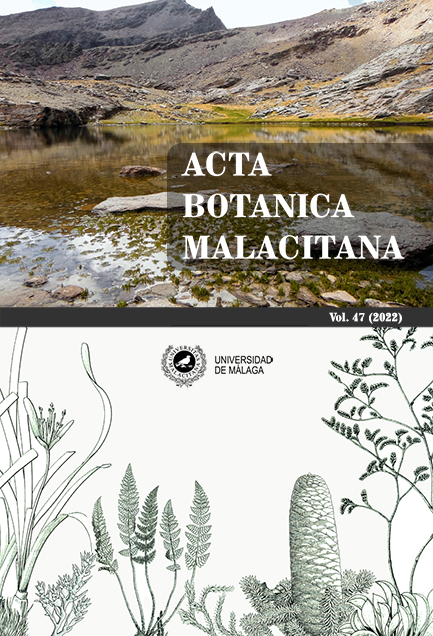Nuevas citas de Taraxacum F.H. Wigg. (Asteraceae) para la flora ibérica
DOI :
https://doi.org/10.24310/abm.v47i.14725Mots-clés :
Dientes de león, distribución, península Ibérica, Taraxacum, taxonomíaRésumé
Se citan por primera vez Taraxacum boekmanii Borgv. y T. subhamatum M.P. Christ. en España, y T. pinto-silvae Soest en la sierra de Gredos (Ávila). Sobre cada especie, se aportan caracteres taxonómicos con fotografías complementarias.
Téléchargements
Métriques
Références
Dudman, A.A. & Richards, A.J. (1997). Dandelions of Great Britain and Ireland. London: Botanical Society of the British Isles.
Franco, J.A. & Rocha Afonso, M.L. (1984). Taraxacum Weber. In J.A. Franco (Ed.), Nova flora de Portugal, Vol. II (pp. 522-534). Lisboa: Sociedade Astória.
Galán de Mera, A. (2017). Taraxacum F.H. Wigg. [nom. cons.]. In S. Castroviejo (Coord.), Flora iberica Vol. XVI (II) (pp. 963-1062). Madrid: Real Jardín Botánico, CSIC.
Galán de Mera, A., Linares-Perea, E. & Vicente-Orellana, J.A. (2017). Taraxacum (Asteraceae) in the Azores, Madeira and the Canary Islands. Annales Botanici Fennici, 54, 273-285. https://doi.org/10.5735/085.054.0610
Kirschner, J. & Št?pánek, J. (1997). A nomenclatural checklist of supraspecific names in Taraxacum. Taxon, 46, 87-98. https://doi.org/10.2307/1224294
Kirschner, J. & Št?pánek, J. (2004). New sections in Taraxacum. Folia Geobotanica, 39, 259-274. https://doi.org/10.1007/BF02804781
Kirschner, J., Štepánek, J. & Greuter, W. [2007+]. Taraxacum. In: W. Greuter & E. Von Raab-Straube (Eds): Compositae. Euro+Med Plantbase - the information resource for Euro-Mediterranean plant diversity. Recurso electrónico en https://www.emplantbase.org/home.html. Consulta realizada el 06/04/2022.
Matysiak, J.P., Tison, J.M. & Ferrez, Y. (2014). Taraxacum F.H. Wigg. In J.M. Tison & B. De Foucault (Coords.), Flora Gallica. Flore de France (pp. 477-508). Mèze: Biotope Éditions.
Øllgaard, H. (1983). Hamata, a new section of Taraxacum (Asteraceae). Plant Systematics and Evolution, 141, 199-217. https://doi.org/10.1007/BF00989002
Richards, A.J. (1985). Sectional nomenclature in Taraxacum (Asteraceae). Taxon, 34(4), 633-644. https://doi.org/10.2307/1222201
Richards, A.J. (1992). The Taraxacum flora of the Sierra de Guadarrama and its surroundings (Spain). Anales del Jardín Botánico de Madrid, 50(2), 201-208.
Richards, A.J. (2003). Apomixis in flowering plants: an overview. Philosophical Transactions of the Royal Society B, 358, 1085-1093. https://doi.org/10.1098/rstb.2003.1294
Richards, A.J. (2012). Taraxacum section Hamata. Plant Crib, 3, 1-10.
Silvertown, J. (2008). The evolutionary maintenance of sexual reproduction: Evidence from the ecological distribution of asexual reproduction in clonal plants. International Journal of Plant Sciences, 169, 157-168. https://doi.org/10.1086/523357
Soest, J.L. (1956). Nouvelle contribution pour la connaissance des Taraxaca du Portugal. Agronomia Lusitana, 18(2), 94-98.
Št?pánek, J. & Kirschner, J. (2022). Taraxacum sect. Erythrocarpa in Europe in the Alps and eastwards: A revision of a precursor group of relicts. Phytotaxa, 536(1), 7-52. https://doi.org/10.11646/phytotaxa.536.1.2
Trávní?ek, B. & Vašut, J. (2011). Notes on the genus Taraxacum in Slovakia. I. Taraxacum sect. Hamata: a new group of dandelions in Slovakia. Biologia, 66(4), 595-603. https://doi.org/10.2478/s11756-011-0058-6
Uhlemann, I. (2003). Die Gattung Taraxacum (Asteraceae) im östlichen Deutschland. Sonderheft: Mitteilungen zur floristichen Kartierung in Sachsen-Anhalt.
Van Baarlen, P., Van Dijk, P.J., Hoekstra, R.F. & De Jong, J.H. (2000). Meiotic recombination in sexual diploid and apomictic triploid dandelions (Taraxacum officinale L.). Genome, 43, 827-835. https://doi.org/10.1139/g00-047.
Vašut, J. (2003). Taraxacum sect. Erythrosperma in Moravia (Czech Republic): Taxonomic notes and the distribution of previously described species. Preslia, 75, 311-338.
Téléchargements
Publiée
Comment citer
Numéro
Rubrique
Licence
Les auteurs qui ont des publications avec cette revue acceptent les termes suivants:
a. Les auteurs conserveront leurs droits d'auteur et garantiront à la revue le droit de première publication de leur travail, qui sera simultanément soumis à la licence Creative Commons Attribution-Non-Commercial 4.0 dont le texte intégral se trouve sur <http: // creativecommons .org / licences / by-nc / 4.0> qui permet à des tiers de partager l'œuvre tant que son auteur et sa première publication sont indiqués, et tant que ce n'est pas à des fins commerciales.
b. Les auteurs peuvent adopter d'autres accords de licence non exclusifs pour la distribution de la version de l'œuvre publiée (par exemple, la déposer dans une archive télématique institutionnelle ou la publier dans un volume monographique) à condition que la publication initiale dans cette revue soit indiquée .
c. Les auteurs sont autorisés et recommandés à diffuser leur travail sur Internet (par exemple, dans les archives télématiques institutionnelles ou sur leur site Web) avant et pendant le processus de soumission, ce qui peut produire des échanges intéressants et augmenter les citations. des travaux publiés. (Voir L'effet de l'accès ouvert).







1.png)
